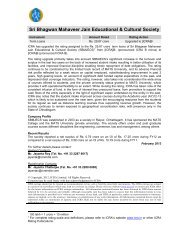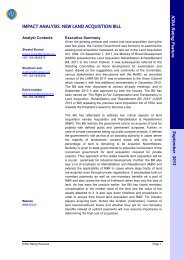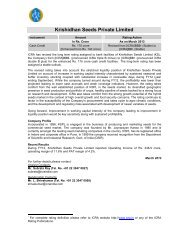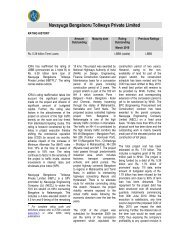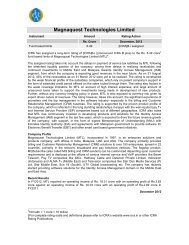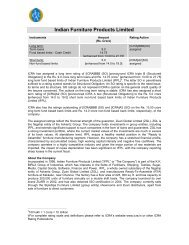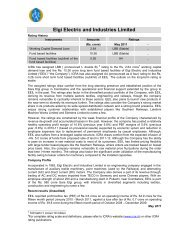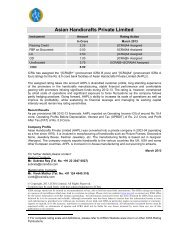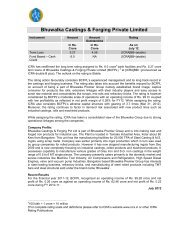Union Government Finances - ICRA
Union Government Finances - ICRA
Union Government Finances - ICRA
Create successful ePaper yourself
Turn your PDF publications into a flip-book with our unique Google optimized e-Paper software.
I C R A B U L L E T I N<br />
Money<br />
&<br />
Finance<br />
<strong>Union</strong> <strong>Government</strong> <strong>Finances</strong><br />
MAY–JUNE 2000<br />
Aside from the issue<br />
of regaining investor<br />
confidence,<br />
<strong>Government</strong> had in<br />
any case its work<br />
cut out to push the<br />
fiscal consolidation<br />
agenda forward<br />
52<br />
Policy Developments<br />
The <strong>Union</strong> Budget 2000 had come as something of a dampener for<br />
most market participants. The more substantive issue was the perceived lack<br />
of teeth in expenditure control, but there were several minor irritants such as<br />
the increase in the rate of dividend tax that rubbed salt into the wounds. The<br />
lack of spirits that followed the February 2000 Budget could not be more in<br />
contrast to the bonhomie following upon the February 1999 Budget. Ever<br />
since March 2000, <strong>Government</strong> has been working at regaining investor<br />
confidence to recoup lost ground. It has not surprisingly, been a difficult<br />
task, with domestic political hurdles to the reform process compounded by<br />
weakness in world equity markets through April, May and June 2000. Aside<br />
from the issue of regaining investor confidence, <strong>Government</strong> had in any case<br />
its work cut out to push the fiscal consolidation agenda forward. This<br />
appears to be progressing along three principal prongs. Namely, expenditure<br />
control, divestment/ privatization and institution change. That is,<br />
besides pushing tax compliance and collections.<br />
Expenditure Control<br />
The Committee on Expenditure Reforms chaired by former Finance<br />
Secretary, Mr. K.P. Geethakrishnan submitted its first report on July 11,<br />
2000. This report reportedly focuses on the food subsidy mess and has restated<br />
the by now widely acknowledged causative link of unchecked farm<br />
lobby pressure working through the support price and procurement mechanism,<br />
coupled with systemic inefficiencies in the public distribution system,<br />
resulting in huge stocks and losses and therefore subsidies. It would appear<br />
that a consensus has arisen in regard of doing away with the present system<br />
of retention pricing and subsidies on nitrogenous fertilizers. It is reported<br />
that the Expenditure Reform Committee’s second report will deal with this<br />
issue and perhaps also touch on streamlining the excessive manning in select<br />
ministries. Budgeted subsidy in 2000-01 for food and nitrogenous fertilizers<br />
is over Rs 8,000 crore each. Drastic overhauling of these subsidy regimes<br />
can increase effectiveness manifold, but the objective of the subsidies—that<br />
is, food support to the poor and assistance to small farmers—are not being<br />
per se questioned. Therefore, while restructuring of the subsidy regimes will<br />
certainly improve the efficiency of the expenditure, one may not necessarily<br />
see a lower fiscal burden in financial terms.
In fact if we see the course of non-interest expenditure over the past<br />
10–15 years, it is quite clear that the major contributor to increase has been<br />
administrative expense, that is employment-related expenses and interest<br />
payments. It also becomes clear that with changes in the country’s demography,<br />
certain expenditures such as pensions which have shot up in the past<br />
five years, will continue to rise rapidly in the near future. The crux of<br />
expenditure control—aside from increasing of its efficiency—is to make<br />
those changes that are necessary to control future expense growth. Abolishing<br />
vacant positions and encouragement to retire through the use of financial<br />
incentives are not likely to generate any immediate significant savings.<br />
On the contrary packages to induce early retirement can temporarily push<br />
up expenses, but this is the only way to ensure that the natural tendency of<br />
the system to self-inflate in the years to come is made as difficult as possible.<br />
It remains to be seen what the Expenditure Reform Committee will<br />
come up with on these tough issues.<br />
Disinvestment / Privatization<br />
The merits of privatization is normally seen to flow from the<br />
efficiency gain through the transfer of asset control away from a moribund<br />
state ownership to (presumably) a more dynamic and efficient private<br />
owner. Divestment of minority stakes in public sector enterprises (PSE) to<br />
portfolio investors, while retaining majority ownership and full control with<br />
<strong>Government</strong>, has been regarded by both the critics and defendants of<br />
disinvestment as “creeping privatization”. The transition to an enterprise<br />
fully governed by commercial principles and independent of administrative<br />
control—though not stockholder control—can be conceived of in a company<br />
with large, even majority, government ownership. The issue is whether<br />
those who effectively exercise the rights of ownership over the PSEs, well<br />
beyond that of what a non-executive owner would be expected to, would<br />
voluntarily give up that power, which comes without the inconvenience of<br />
accountability 1 . The attempt to separate the politician–virtual CEO from<br />
the company in which his ministry exercises ownership on behalf of the<br />
President of the Republic, is a difficult one, and the pangs of pain are<br />
evident for all to see in PSE after PSE.<br />
In any event, the NDA government has clearly placed the divestment<br />
/ privatization process high on the agenda, as being relatively more<br />
‘do-able’, and with the added benefit of early completion and immediate<br />
fiscal benefits. The (financial) liabilities of the central government as on<br />
March 31, 2000 amounted to about Rs 1,030,000 crore. This is matched on<br />
the asset side by loans of about Rs 215,000 crore to state governments;<br />
Rs 1,000 crore to foreign governments; Rs 51,300 crore to central enterprises<br />
and Rs 1,700 crore to government servants, that is, total loan assets<br />
of Rs 267,000 crore. The Central government earned Rs 34,144 crore from<br />
I C R A B U L L E T I N<br />
Money<br />
&<br />
Finance<br />
MAY–JUNE 2000<br />
The crux of<br />
expenditure<br />
control—aside from<br />
increasing of its<br />
efficiency—is to<br />
make those changes<br />
that are necessary to<br />
control future<br />
expense growth<br />
1<br />
The experience of Steel Authority of India Limited (SAIL) is an excellent, but<br />
perhaps something of an extreme example of what havoc unbridled powers to decide<br />
without the burden of continuing and clear accountability have wrought.<br />
53
I C R A B U L L E T I N<br />
Money<br />
&<br />
Finance<br />
MAY–JUNE 2000<br />
It will certainly<br />
require divestment<br />
receipts of a for<br />
greater order of<br />
magnitude if the<br />
debt burden is to be<br />
sufficiently reduced<br />
so as to conceive of<br />
an elimination of the<br />
revenue deficit<br />
these loans assets, an (average) yield of 13.1 per cent, that is well over its<br />
average cost of liabilities, which is 9.5 per cent.<br />
A sum of Rs 311,000 crore is invested in departments of the Central<br />
government and as equity in Central PSEs. On these assets, the Centre<br />
earned dividend and profits of Rs 9,311 crore, out of which as much as<br />
Rs 4,479 crore was the surplus of the Reserve Bank of India (RBI). If we<br />
exclude RBI’s profits, the return on the Centre’s investment of Rs 311,000<br />
crore is a miserable 1.6 per cent. But the sum of the loan and direct capital<br />
assets add up to only Rs 578,000 crore. What about the balance liabilities of<br />
Rs 453,000 crore? Well these are “the excess of liabilities over capital<br />
outlay and loans advanced”—that is, there are no counterpart tangible<br />
assets. In business it is equivalent to the funded accumulated loss, in the case<br />
of government it is the accumulated revenue deficits funded from public debt<br />
and other (almost all interest bearing) liabilities.<br />
So, divestment—that is, selling the equity investment of government<br />
(which on the aggregate yields 1.6 per cent and costs 9.5 per cent)—is<br />
clearly integral to scaling down of government debt. But is divestment /<br />
privatization on the scale required—namely not in terms of the Rs 10,000<br />
crore indicated in the Budget for 2000-01, but in perhaps hundred thousand<br />
crore—on the cards? It will certainly take that kind of receipts to sufficiently<br />
reduce debt and the annual interest burden, in order to conceive of eliminating<br />
the revenue deficit. The current market value of many kinds of government<br />
investments such as in telecommunications, railways and other<br />
infrastructure are surely many times their book value, and to that extent the<br />
value of certain <strong>Union</strong> economic assets are understated. Further, changing<br />
technology and economics have imparted considerable market value to<br />
franchises—such as radio bandwidth—for which there are no counterpart<br />
financial liabilities.<br />
Notwithstanding the obvious differences within the ruling alliance,<br />
the <strong>Union</strong> Cabinet has continued to move forward. Global advisors have<br />
been appointed for 16 PSEs, including Air India, Indian Airlines, National<br />
Fertilizer and Indian Tourism Development Corporation. The attitude<br />
towards sale to foreign companies—‘strategic partners’—has also become<br />
somewhat more relaxed with a foreign partner being sought for Air India. In<br />
the case of the latter company a deadline (March 2001) has reportedly been<br />
given.<br />
Fiscal Responsibility Act<br />
The Bill for instituting a Fiscal Responsibility Act designed to<br />
institutionalize a degree of fiscal prudence and lay down clear-cut parameters<br />
governing the conduct of financial management has reportedly been<br />
finalized and is likely to be tabled in the forthcoming monsoon session of<br />
Parliament.<br />
54
<strong>Union</strong> <strong>Government</strong> <strong>Finances</strong><br />
Fiscal 1999-2000<br />
For the record, the ‘actual’ financial numbers for the completed<br />
year 1999-2000, has after the closing of accounts on April 24, 2000, turned<br />
out to be better than the revised estimates presented in the <strong>Union</strong> Budget.<br />
The ‘actuals’ are the unaudited provisional figures and ought not to be at<br />
significant variance with the audited ‘actuals’. The principal differences<br />
with respect to 2000-01 RE are summarized:<br />
• Tax revenues ↑:<br />
• Non-interest revenue<br />
expenditure ↓:<br />
• Interest expenses ↓:<br />
• Revenue expenditure ↓:<br />
• Revenue deficit ↓:<br />
• Capital expenditure and<br />
net lending ↑:<br />
• Gross fiscal deficit ↓:<br />
• Disinvestment proceeds ↓:<br />
• Fiscal deficit ↓:<br />
• Primary deficit ↓:<br />
Up by Rs 2,042 crore (1.6 per cent)<br />
Lower by Rs 2,877 crore (1.8 per cent)<br />
Up by Rs 436 crore (0.5 per cent)<br />
Down by Rs 2,441 crore (1.0 per cent)<br />
Lower by Rs 4,371 crore (5.9 per cent)<br />
Higher by Rs 1,317 crore (3.5 per cent)<br />
Lower by Rs 3.054 crore (2.7 per cent)<br />
Lower by Rs 880 crore (33.8 per cent)<br />
Lower by Rs 2,174 crore (2.0 per cent)<br />
Lower by Rs 2,610 crore (14.9 per cent)<br />
Fiscal 2000-01<br />
The summary of the financial position of the <strong>Union</strong> government is<br />
provided on a monthly basis by the Controller General of Accounts (CGA)<br />
of the Ministry of Finance and is currently available up to May 2000. It has<br />
been reported that tax collections—indirect and especially direct—have<br />
increased by a record proportion of 23.8 per cent in the first quarter of<br />
2000-01. It is necessary to point out that in 1999, tax collections had<br />
actually fallen in the first quarter compared to the previous year, on account<br />
of large refunds in the month of April which resulted in negative net tax<br />
collections to the Centre for the month. To what extent the 23.8 per cent rise<br />
in gross tax collections translate into receipts to the <strong>Union</strong> can only be seen<br />
in end-July/early-August when the <strong>Union</strong> accounts for June 2000 will<br />
become available.<br />
However we can compare the growth in gross tax collections for<br />
the period April to May with the movement in net tax receipts to the Centre.<br />
In the two month period of April and May 2000, tax collections at Rs<br />
21,103 crore were higher than in the previous year by 21.7 per cent. The net<br />
tax receipts to the Centre for this period at Rs 10,428 crore were higher only<br />
by 12.4 per cent. That too was on account of the 20 per cent fall in net tax<br />
receipts in the April–May period of 1999 compared to 1998. Thus, the<br />
April–May 2000 amount of Rs 10,428 crore is actually lower than that<br />
received during April–May of 1998 (Rs 11,588 crore) and even that of 1997<br />
(Rs 10,898 crore). It is of course possible that devolution to the States has<br />
been stepped up in line with the 29 per cent of ‘net’ collection formula, but<br />
the amount is not likely to be more than a few hundred crore. There does<br />
not appear to be any strong reason to believe that the record 23.8 per cent<br />
I C R A B U L L E T I N<br />
Money<br />
&<br />
Finance<br />
MAY–JUNE 2000<br />
The actual<br />
unaudited numbers<br />
for 1999–2000 has<br />
turned out to be<br />
better than in the<br />
Revised Estimates<br />
presented in the<br />
<strong>Union</strong> Budget in<br />
February 2000<br />
55
I C R A B U L L E T I N<br />
Money<br />
&<br />
Finance<br />
MAY–JUNE 2000<br />
rise in gross tax in the first quarter will translate into net tax receipts<br />
qualitatively superior to that during the April–May period.<br />
Financial position April–May 2000<br />
The highlights of the financial position for the period April–May<br />
2000 (Table-1) indicate that:<br />
• Net tax receipts to Centre are still running short of BE growth,<br />
despite that fact that tax growth was actually negative in the<br />
corresponding period of 1999. It is to be seen as to what extent this<br />
deficiency is compensated for by the June 2000 numbers<br />
• Huge surge in non-tax revenues by 106 per cent. Perhaps on<br />
account of early payment of dividends by central PSEs which have<br />
also sought to save the higher rate of dividend tax applicable after<br />
June 2000.<br />
• Because of the doubling of non-tax revenues, current receipts rise by<br />
31 per cent<br />
• This is however more than compensated for by the sharp growth in<br />
Plan revenue expenditure (73 per cent) and continued expansion on<br />
the non-Plan side<br />
TABLE 1<br />
Change in Principal Fiscal Indicators for the Central <strong>Government</strong><br />
Up to the end of May 2000<br />
Items<br />
Actuals*<br />
Budget<br />
Change proposed in<br />
for 1999-<br />
Estimates<br />
Budget Estimates over<br />
2000 2000-01 Actuals* 1999-00<br />
Rs Crore<br />
percent<br />
Quantum of change in<br />
April-May 2000 compared<br />
to April-May 1999 – Period<br />
of 2 months<br />
Rs crore<br />
per cent<br />
Tax Revenue (net to the Centre)<br />
e) 128,511 146,209 17,698 13.8% 1,151 12.4%<br />
Non-tax revenue Receipts 52,923 57,464 4,541 8.6% 2,491 104.5%<br />
Total Receipts (net) 181,434 203,673 22,239 12.3% 3,642 31.2%<br />
Non-Plan Revenue Expenditure 203,454 228,768 25,314 12.4% 1,360 5.5%<br />
Plan Revenue Expenditure 47,141 52,330 5,189 11.0% 3,159 72.9%<br />
Revenue Expenditure 250,595 281,098 30,503 12.2% 4,519 15.5%<br />
Primary Revenue Surplus 22,700 23,841 1,141† 5.0% 1,319† 24.3%<br />
Revenue Deficit 69,161 77,425 8,264† 11.9% 877† 5.0%<br />
Capital Expenditure + Net Lending 39,283 43,850 4,567 11.6% 532 10.9%<br />
Gross Financing Deficit 108,444 121,275 22,357† 11.8% 1,409† 6.3%<br />
Other non-debt capital receipts 1,720 10,000 346 481.4% –101 –29.2%<br />
Fiscal Deficit 106,724 111,275 22,011 4.3% 1,510† 6.9%<br />
Primary Deficit 14,863 10,009 –4,854# –32.7% –686# –6.9%<br />
Source: Annual data from <strong>Union</strong> Budget and April-November data from Controller General of Accounts, Ministry of<br />
Finance, website: www.cga.nic.in<br />
Note: * ‘Actuals’ are the Unaudited Provisional figures finalized after the closing of accounts on April 24, 2000.<br />
† Primary Revenue, Revenue and Gross Financing Balance: a negative number denotes a deficit and a positive<br />
number a surplus<br />
# The primary deficit has become larger in the April–May 2000 period over comparable period in the last fiscal.<br />
56
• In consequence the revenue deficit has gone up by 5 per cent—an<br />
expansion that is less than that estimated for the full year<br />
• Capital expenditure and net lending has gone up by 11 per cent,<br />
roughly in line with the Budget for the full year<br />
• Gross fiscal deficit has expanded by 6 per cent, again an expansion<br />
that is less than what has been estimated for the full year<br />
• Divestment proceeds have been much lower by as much as 29 per<br />
cent<br />
• This resulted in a fiscal deficit that increased by 7 per cent, more<br />
than the budgeted trend of 4 per cent for the full year<br />
On the whole the higher level of tax and non-tax receipts has gone<br />
to support an equally higher level of (primarily) Plan revenue and capital<br />
expenditure, leaving the deficit figures a little larger than in the corresponding<br />
period of the last financial year. This can also be observed from the<br />
borrowing position of the <strong>Union</strong> government in May (Table-2). Since the<br />
borrowing data is provided on a reporting Friday basis by the Reserve Bank<br />
of India it is generally not possible to obtain the end of month figures, till<br />
the CGA issues the account position. By picking a Friday closest to the end<br />
of the month, one misses out the working days in the following week and<br />
before the end of the calendar month, which is relevant on the receipt side.<br />
TABLE 2<br />
Increase in Funds Borrowed by the Central <strong>Government</strong><br />
Over previous end-March<br />
Unit: : Rs crore<br />
Period / reference Net Amount of Treasury Bills Ways & Total Central<br />
date which is Long-term and of different Means <strong>Government</strong><br />
reporting Medium-term Maturities Advances Borrowings<br />
Friday<br />
borrowings<br />
APRIL–MAY 2000<br />
May 26, 2000 22,707 –43 9,093 31,757<br />
May 28, 1999 22,273 87 3,464 25,824<br />
Increase in 2000 † 434 –130 5,629 5,933<br />
June 02, 2000 24,707 2,695 255 27,657<br />
June 04, 1999 27,273 2,266 4,910 34,449<br />
Increase in 2000 † –2,566 429 –4,655 –6,792<br />
I C R A B U L L E T I N<br />
Money<br />
&<br />
Finance<br />
MAY–JUNE 2000<br />
For the first 2<br />
months of 2000-01,<br />
the higher level of<br />
tax and non-tax<br />
receipts has gone to<br />
support an equally<br />
higher level of<br />
(primarily) Plan<br />
revenue and capital<br />
expenditure, leaving<br />
the deficit figures a<br />
little larger<br />
APRIL–JUNE 2000<br />
June 30, 2000 28,500 –560 7,358 35,298<br />
June 25, 1999 30,273 1,243 4,755 36,271<br />
Increase in 2000 † –1,773 –1,803 2,603 –973<br />
June 30, 2000 28,500 –560 7,358 35,298<br />
July 02, 1999 34,903 2,041 7,720 44,664<br />
Increase in 2000 † –6,403 –2,601 –362 –9,366<br />
Note: † A negative sign denotes that the year-to-date increase in borrowings over<br />
previous March 31 is smaller than that for the comparable period in the last<br />
financial year.<br />
Source: Weekly Statistical Supplement, Reserve Bank of India, various issues<br />
57
I C R A B U L L E T I N<br />
Money<br />
58<br />
&<br />
Finance<br />
MAY–JUNE 2000<br />
Based on data<br />
showing lower<br />
borrowing by the<br />
central government<br />
one can perhaps<br />
surmise that at the<br />
end of the first<br />
quarter of 2000-01,<br />
the fiscal deficit was<br />
lower than that for<br />
the first quarter of<br />
1999-2000 by at<br />
least a couple of<br />
thousand crore<br />
By picking a Friday just after the end of the month, the error comes from the<br />
salaries that have been paid out in the first few days of the new month. At<br />
Table-2, the borrowing position—or rather the increase in the borrowing<br />
position over preceding March 31– has been worked out for the April–May<br />
and for the April–June period, using both last reporting Friday of the month<br />
and the first reporting Friday of the next. As can be seen the choice of<br />
Friday makes for a large difference in both periods on account of the two<br />
sources of errors mentioned above.<br />
The CGA indicates that the fiscal deficit for April–May 2000 was<br />
higher by Rs 1,510 crore, which is rather different from either of the two<br />
estimates at Table-2, one based on the last Friday of May and the other on<br />
the first Friday of June. Clearly looking at the two estimates of increased<br />
borrowing levels the best that could be guessed is that the fiscal deficit up to<br />
the end of May 2000 would be somewhat less than Rs 5,000 crore compared<br />
to the first two month of the previous fiscal.<br />
Fortunately the last reporting Friday of June 2000 was also the last<br />
day of the month. However for 1999, June 25 leaves three working days out<br />
and July 2 includes two days. Nevertheless the alternate measures the<br />
increase in borrowings is negative in both cases. Therefore, one can perhaps<br />
surmise that at the end of the first quarter of 2000-01, the fiscal deficit was<br />
lower than that for the first quarter of 1999-2000 by at least a couple of<br />
thousand crore.<br />
Outlook<br />
The outlook for <strong>Union</strong>, and for that matter the combined <strong>Union</strong> and<br />
State finances, are certainly better than at any point in the previous four<br />
years. With the economic recovery still underway (notwithstanding the<br />
CSO’s July press note on Industrial Production), external conditions again<br />
better than in previous years, no cross-border conflict till date, and clear<br />
movement on the front of economic reforms, <strong>Union</strong> finances are quite likely<br />
to stay to the budgeted course. There might well be an increase in transfer<br />
payments to States on account of the recommendations of the Eleventh<br />
Finance Commission, but much of it has already been budgeted for and<br />
enhanced revenue collections in the year likely to finance a part of the<br />
incremental transfers. Thus, the <strong>Union</strong> may not have to finance the entirety<br />
of incremental transfers over the budgeted amount with additional debt.<br />
Movement on privatization of <strong>Union</strong> assets is also likely to encourage State<br />
governments to push ahead with the reform of their own public sector. Of<br />
particular importance is the power sector (state electricity boards and in<br />
some cases their progeny), which alone has been generating a massive hole<br />
in the finances of the States. In a federal set-up it is difficult for individual<br />
States to be greatly reform minded if the <strong>Union</strong> is equivocal about it. The<br />
greater focus of the Centre on these issues therefore imparts the necessary<br />
role of leadership and co-ordination that can sustain reform-minded States<br />
to press on with their agenda.
Appendices<br />
I C R A B U L L E T I N<br />
Money<br />
&<br />
Finance<br />
MAY–JUNE 2000
I C R A B U L L E T I N<br />
Money<br />
&<br />
Finance<br />
Appendices<br />
MAY–JUNE 2000<br />
Components and Sources of Money Stock (M 3 ) and their Variations (Rs cror<br />
ores): 1998–99, 1999–2000 and 2000–01<br />
March 31 April May June July<br />
1998 1999 2000 1999 2000 1999 2000 1998 1999 1998 1999<br />
M3 825,389 972,204 1,111,707 988,295 1,148,816 1,000,036 1,155,203 855,797 1,010,749 861,934 1,018,205<br />
a) % change during the month 1.7% 3.3% 1.2% 0.6% 1.0% 1.1% 0.7% 0.7%<br />
b) % change since March 31 1.7% 3.3% 2.9% 18.8% 3.7% 4.0% 4.4% 4.7%<br />
Components of M3 ( 1+2+3+4)<br />
1 Currency with public 145,182 169,382 189,319 179,549 201,549 185,289 201,071 158,098 185,317 150,509 177,075<br />
a) % change during the month 6.0% 6.5% 3.2% -0.2% -0.8% 0.0% -4.8% -4.4%<br />
b) % change since March 31 6.0% 6.5% 9.4% 18.7% 8.9% 9.4% 3.7% 4.5%<br />
2 Demand deposits with banks 118,435 135,111 147,353 130,016 149,775 126,694 148,595 112,053 124,873 114,792 127,378<br />
a) % change during the month -3.8% 1.6% -2.6% -0.8% -13.8% -1.4% 2.4% 2.0%<br />
b) % change since March 31 -3.8% 1.6% -6.2% 10.0% -5.4% -7.6% -3.1% -5.7%<br />
3 Time deposits with banks 558,167 663,890 771,930 675,522 794,852 685,064 803,120 581,237 695,652 592,303 709,125<br />
a) % change during the month 1.8% 3.0% 1.4% 1.0% 2.0% 1.5% 1.9% 1.9%<br />
b) % change since March 31 1.8% 3.0% 3.2% 21.0% 4.1% 4.8% 6.1% 6.8%<br />
4 Other deposits with RBI 3,604 3,821 3,105 3,208 2,641 2,989 2,417 4,409 4,907 4,330 4,627<br />
a) % change during the month -16.0% -14.9% -6.8% -8.5% 77.0% 64.2% -1.8% -5.7%<br />
b) % change since March 31 -16.0% -14.9% -21.8% -36.7% 22.3% 28.4% 20.1% 21.1%<br />
Sources of M3 (5+6+7+8-9)<br />
5 Net bank credit to govt.(i+ii) 330,619 387,151 442,136 398,476 461,142 405,221 470,797 360,598 412,105 366,717 418,734<br />
a) % change during the month 2.9% 4.5% 1.7% 2.1% 3.1% 1.7% 1.7% 1.6%<br />
b) % change since March 31 2.9% 4.5% 4.7% 21.6% 9.1% 6.4% 10.9% 8.2%<br />
i<br />
RBI’s credit<br />
135,160 152,539 149,029 155,963 144,642 155,179 152,893 150,342 155,968 150,672 156,263<br />
a) % change during the month 2.2% -2.4% -0.5% 5.7% 5.8% 0.5% 0.2% 0.2%<br />
b) % change since March 31 2.2% -2.4% 1.7% 0.2% 11.2% 2.2% 11.5% 2.4%<br />
ii<br />
Other banks’ credit 195,460 234,612 293,107 242513 250042 317,904 210256 256137 216045 262471<br />
a) % change during the month 3.4% 8.0% 3.1% 0.4% 1.3% 2.4% 2.8% 2.5%<br />
b) % change since March 31 3.4% 8.0% 6.6% 35.5% 7.6% 9.2% 10.5% 11.9%<br />
6 Bank credit to commercial<br />
sector (i+ii) 432,190 490,363 575,921 490,832 582,929 491,691 582,760 428,206 489,356 432,953 495,489<br />
a) % change during the month 0.1% 1.2% 0.2% 0.0% -0.4% -0.5% 1.1% 1.3%<br />
b) % change since March 31 0.1% 1.2% 0.3% 18.8% -0.9% -0.2% 0.2% 1.0%<br />
i<br />
RBI’s credit<br />
8,186 12,226 15,270 10,269 8,591 10,200 10,632 8,439 9,332 8,469 9,231<br />
a) % change during the month -16.0% -43.7% -0.7% 23.8% 0.9% -8.5% 0.4% -1.1%<br />
b) % change since March 31 -16.0% -43.7% -16.6% -13.0% 3.1% -23.7% 3.5% -24.5%<br />
ii<br />
Other banks’ credit 424,004 478,137 560,651 480,563 574,338 481,491 572,128 419,767 480,024 424,484 486,258<br />
a) % change during the month 0.5% 2.4% 0.2% -0.4% -0.4% -0.3% 1.1% 1.3%<br />
b) % change since March 31 0.5% 2.4% 0.7% 19.7% -1.0% 0.4% 0.1% 1.7%<br />
7 Net foreign exchange assets<br />
of the banking sector 126,569 164,362 194,433 165,565 193,168 181,797 194,021 126,234 182,362 125,663 183,699<br />
a) % change during the month 0.7% -0.7% 9.8% 0.4% -0.6% 0.3% -0.5% 0.7%<br />
b) % change since March 31 0.7% -0.7% 10.6% 18.0% -0.3% 11.0% -0.7% 11.8%<br />
8 <strong>Government</strong>’s currency liabilities<br />
to the public 3,120 3,846 4,194 3,846 4,194 3,924 4,194 3,482 4,020 3,522 4,079<br />
a) % change during the month 0.0% 0.0% 2.0% 0.0% 7.4% 2.4% 1.1% 1.5%<br />
b) % change since March 31 0.0% 0.0% 2.0% 9.0% 11.6% 4.5% 12.9% 6.1%<br />
9 NNML of the banking sector (i+ii) 67,110 73,518 104,977 70,424 92,617 82,597 96,569 62,723 77,094 66,921 83,796<br />
a) % change during the month -4.2% -11.1% 17.3% 4.3% -1.8% -6.7% 6.7% 8.7%<br />
b) % change since March 31 -4.2% -11.1% 12.3% 313.5% -6.5% 4.9% -0.3% 14.0%<br />
i<br />
RBI’s NNML 43,219 60,455 70,916 60,951 70,493 61,502 76,280 53,887 63,267 58,301 67,276<br />
a) % change during the month 0.8% 0.5% 0.9% 8.2% 9.6% 2.9% 8.2% 6.3%<br />
b) % change since March 31 0.8% 0.5% 1.7% 26.2% 24.7% 4.7% 34.9% 11.3%<br />
ii<br />
Other bank’s NNML(Residual) 23,891 13,063 34,061 9,473 22,124 21,095 20,289 8,836 13,827 8,620 16,520<br />
a) % change during the month -27.5% -35.0% 122.7% -8.3% -39.8% -34.5% -2.4% 19.5%<br />
b) % change since March 31 -27.5% -35.0% 61.5% 55.3% -63.0% 5.8% -63.9% 26.5%<br />
Note:<br />
Source:<br />
For 1997& 1998 data taken from RBI Annual Report 1997-98 pg. Appendix 156; Figures within brackets indicate negative (-ve) numbers<br />
Reserve Bank of India, Monthly Bulletin and Weekly Statistical Supplement
I C R A B U L L E T I N<br />
Money<br />
&<br />
Finance<br />
MAY–JUNE 2000<br />
August September October November December January February March<br />
1998 1999 1998 1999 1998 1999 1998 1999 1998 1999 1999 2000 1999 2000 1999 2000<br />
882,705 1,029,433 895,718 1,043,298 915,768 1,057,392 919,325 1,065,879 928,777 1,088,696 940,467 1,089,004 948,978 1,105,153 974,328 1,111,707<br />
2.4% 1.1% 1.5% 1.3% 2.2% 1.4% 0.4% 0.8% 1.0% 2.1% 1.3% 0.0% 0.9% 1.5% 2.7% 0.6%<br />
6.9% 5.9% 8.5% 7.3% 10.9% 8.8% 11.4% 9.6% 12.5% 11.98% 13.9% 12.0% 15.0% 13.7% 18.0% 14.3%<br />
0 0 0<br />
149,970 177,203 151,437 176,879 159,396 183,121 158,750 190,452 162,445 193,114 165,186 189,774 168,135 191,417 170,119 189,319<br />
-0.4% 0.1% 1.0% -0.2% 5.3% 3.5% -0.4% 4.0% 2.3% 1.4% 1.7% -1.7% 1.8% 0.9% 1.2% -1.1%<br />
3.3% 4.6% 4.3% 4.4% 9.8% 8.1% 9.3% 12.4% 11.9% 14.01% 13.8% 12.0% 15.8% 13.0% 17.2% 11.8%<br />
111,225 127,110 114,555 129,460 116,010 131,718 116,067 128,344 115,355 133,020 118,706 138,337 118,639 141,931 130,267 147,353<br />
-3.1% -0.2% 3.0% 1.8% 1.3% 1.7% 0.0% -2.6% -0.6% 3.6% 2.9% 4.0% -0.1% 2.6% 9.8% 3.8%<br />
-6.1% -5.9% -3.3% -4.2% -2.0% -2.5% -2.0% -5.0% -2.6% -1.55% 0.2% 2.4% 0.2% 5.0% 10.0% 9.1%<br />
616,754 720,801 625,953 732,419 636,843 739,534 640,916 743,799 646,987 759,290 653,465 757,760 659,002 769,144 670,130 771,930<br />
4.1% 1.6% 1.5% 1.6% 1.7% 1.0% 0.6% 0.6% 0.9% 2.1% 1.0% -0.2% 0.8% 1.5% 1.7% 0.4%<br />
10.5% 8.6% 12.1% 10.3% 14.1% 11.4% 14.8% 12.0% 15.9% 14.37% 17.1% 14.1% 18.1% 15.9% 20.1% 16.3%<br />
4,756 4,319 3,773 4,540 3,519 3,019 3,592 3,284 3,990 3,272 3,110 3,133 3,202 2,661 3,812 3,105<br />
9.8% -6.7% -20.7% 5.1% -6.7% -33.5% 2.1% 8.8% 11.1% -0.4% -22.1% -4.2% 3.0% -15.1% 19.1% 16.7%<br />
32.0% 13.0% 4.7% 18.8% -2.4% -21.0% -0.3% -14.1% 10.7% -14.37% -13.7% -18.0% -11.2% -30.4% 5.8% -18.7%<br />
0.00 0.00<br />
363,716 419,659 366,624 423,131 371,436 432,489 379,472 434,248 380,844 441,233 382,769 436,849 386,870 437,796 384,266 441,371<br />
-0.8% 0.2% 0.8% 0.8% 1.3% 2.2% 2.2% 0.4% 0.4% 1.6% 0.5% -1.0% 1.1% 0.2% -0.7% 0.8%<br />
10.0% 8.4% 10.9% 9.3% 12.3% 11.7% 14.8% 12.2% 15.2% 13.97% 15.8% 12.8% 17.0% 13.1% 16.2% 14.0%<br />
140,637 150,668 136,420 150,978 148,869 158,583 151,453 156,970 149,262 157,207 151,796 151,435 154,369 148,242 150,132 148,264<br />
-6.7% -3.6% -3.0% 0.2% 9.1% 5.0% 1.7% -1.0% -1.4% 0.2% 1.7% -3.7% 1.7% -2.1% -2.7% 0.0%<br />
4.1% -1.2% 0.9% -1.0% 10.1% 4.0% 12.1% 2.9% 10.4% 3.06% 12.3% -0.7% 14.2% -2.8% 11.1% -2.8%<br />
223079 268991 230204 272153 222567 273906 228019 277278 231582 284026 230973 285414 232501 289554 234133 293107<br />
3.3% 2.5% 3.2% 1.2% -3.3% 0.6% 2.4% 1.2% 1.6% 2.4% -0.3% 0.5% 0.7% 1.5% 0.7% 1.2%<br />
14.1% 14.7% 17.8% 16.0% 13.9% 16.7% 16.7% 18.2% 18.5% 21.06% 18.2% 21.7% 19.0% 23.4% 19.8% 24.9%<br />
433,804 498,361 437,192 503,966 448,431 520,120 447,729 521,729 452,367 540,309 465,782 546,676 468,857 561,129 486,942 575,921<br />
0.2% 0.6% 0.8% 1.1% 2.6% 3.2% -0.2% 0.3% 1.0% 3.6% 3.0% 1.2% 0.7% 2.6% 3.9% 2.6%<br />
0.4% 1.6% 1.2% 2.8% 3.8% 6.1% 3.6% 6.4% 4.7% 10.19% 7.8% 11.5% 8.5% 14.4% 12.7% 17.4%<br />
8,200 9,594 8,182 9,778 8,228 11,582 8,302 10,087 8,347 9,033 8,401 9,806 8,504 13,287 12,226 15,270<br />
-3.2% 3.9% -0.2% 1.9% 0.6% 18.4% 0.9% -12.9% 0.5% -10.4% 0.6% 8.6% 1.2% 35.5% 43.8% 14.9%<br />
0.2% -21.5% 0.0% -20.0% 0.5% -5.3% 1.4% -17.5% 2.0% -26.12% 2.6% -19.8% 3.9% 8.7% 49.4% 24.9%<br />
425,604 488,767 429,010 494,188 440,203 508,538 439,427 511,642 444,020 531,276 457,381 536,870 460,353 547,842 474,717 560,651<br />
0.3% 0.5% 0.8% 1.1% 2.6% 2.9% -0.2% 0.6% 1.0% 3.8% 3.0% 1.1% 0.6% 2.0% 3.1% 2.3%<br />
0.4% 2.2% 1.2% 3.4% 3.8% 6.4% 3.6% 7.0% 4.7% 11.11% 7.9% 12.3% 8.6% 14.6% 12.0% 17.3%<br />
128,157 182,401 134,620 182,322 136,042 182,396 135,995 175,143 137,050 180,461 139,985 180,561 141,342 183,826 148,633 194,433<br />
2.0% -0.7% 5.0% 0.0% 1.1% 0.0% 0.0% -4.0% 0.8% 3.0% 2.1% 0.1% 1.0% 1.8% 5.2% 5.8%<br />
1.3% 11.0% 6.4% 10.9% 7.5% 11.0% 7.4% 6.6% 8.3% 9.79% 10.6% 9.9% 11.7% 11.8% 17.4% 18.3%<br />
3,522 4,079 3,522 4,079 3,561 4,079 3,670 4,188 3,705 4,194 3,705 4,194 3,705 4,194 3,705 4,194<br />
0.0% 0.0% 0.0% 0.0% 1.1% 0.0% 3.1% 2.7% 1.0% 0.1% 0.0% 0.0% 0.0% 0.0% 0.0% 0.0%<br />
12.9% 6.1% 12.9% 6.1% 14.1% 6.1% 17.6% 8.9% 18.8% 9.05% 18.8% 9.0% 18.8% 9.0% 18.8% 9.0%<br />
46,494 75,067 46,240 70,200 43,702 81,692 47,541 69,429 45,189 77,501 51,774 79,276 51,796 81,792 49,218 104,212<br />
-30.5% -10.4% -0.5% -6.5% -5.5% 16.4% 8.8% -15.0% -4.9% 11.6% 14.6% 2.3% 0.0% 3.2% -5.0% 27.4%<br />
-30.7% 2.1% -31.1% -4.5% -34.9% 11.1% -29.2% -5.6% -32.7% 5.42% -22.9% 7.8% -22.8% 11.3% -26.7% 41.8%<br />
53,804 62,847 55,897 64,277 57,487 66,258 56,889 66,557 59,027 66,905 60,801 68,201 59,954 69,780 58,058 70,151<br />
-7.7% -6.6% 3.9% 2.3% 2.8% 3.1% -1.0% 0.5% 3.8% 0.5% 3.0% 1.9% -1.4% 2.3% -3.2% 0.5%<br />
24.5% 4.0% 29.3% 6.3% 33.0% 9.6% 31.6% 10.1% 36.6% 10.67% 40.7% 12.8% 38.7% 15.4% 34.3% 16.0%<br />
(7,310) 12,220 (9,657) 5,923 (13,785) 15,434 (9,348) 2,872 (13,838) 10,596 (9,027) 11,075 (8,158) 12,012 (8,840) 34,061<br />
-184.8% -26.0% 32.1% -51.5% 42.7% 160.6% -32.2% -81.4% 48.0% 268.9% -34.8% 4.5% -9.6% 8.5% 8.4% 183.6%<br />
-130.6% -6.5% -140.4% -54.7% -157.7% 18.2% -139.1% -78.0% -157.9% -18.89% -137.8% -15.2% -134.1% -8.0% -137.0% 160.7%
I C R A B U L L E T I N<br />
Money<br />
&<br />
Finance<br />
MAY–JUNE 2000<br />
Movements of Selected Interest Rates and Rate of Inflation : 1998-99 and 1999-2000<br />
(Unit: percentage)<br />
Modal Call MIBOR 91-day T-Bills 364-day T-Bills Long Term Govern-<br />
Money Rate<br />
ment Securities<br />
Month 1998- 1999- 2000- 1998- 1999- 2000- 1998- 1999- 2000- 1998- 1999- 2000- 1998- 1999- 2000-<br />
99 2000 2001 99 2000 2001 99 2000 2001 99 2000 2001 99 2000 2001<br />
Apr 7.1 7.2 6.5 7.9 6.8 7.8 8.4 8.4 7.8 9.3 9.1 11.9 11.8 10.2<br />
M a y 6.8 8.7 7.5 9.0 7.6 8.7 8.5 8.2 8.4 9.7 9.2 11.8 11.6 10.3<br />
Jun 6.3 8.2 11.2 6.9 8.3 11.4 8.7 8.8 9.0 8.3 10.1 9.6 11.9 11.6 10.6<br />
Jul 5.9 8.2 6.4 8.4 7.7 8.9 8.2 9.7 12.0 11.6<br />
Aug 8.0 9.9 8.6 9.9 7.8 9.0 8.7 9.8 11.8 11.4<br />
Sep 8.5 9.8 8.7 10.1 8.8 9.4 9.4 10.4 12.1 11.3<br />
Oct 8.4 11.2 8.6 11.3 9.6 9.9 10.1 10.3 12.3 11.3<br />
Nov 8.1 8.2 8.1 8.2 9.0 9.1 9.8 9.7 12.1 11.2<br />
Dec 8.3 7.8 8.5 7.9 9.0 8.7 10.2 9.8 12.1 11.1<br />
Jan 10.2 8.0 10.8 8.1 9.0 8.9 10.3 10.8 12.1 10.9<br />
Feb 9.0 10.7 9.1 10.7 9.0 8.6 10.2 9.3 12.2 10.4<br />
Mar 8.6 9.6 8.8 9.8 8.6 9.1 9.9 9.5 11.9 10.6<br />
Note:<br />
Source:<br />
Long term govt securities—Average of 5-10 years GOI rates;<br />
Figures of Jun-00 are based on the data upto 15th June-00<br />
Business Standard, Business Line, RBI Bulletin-Weekly Statistical Supplement; MIBOR: NSE Website (Data<br />
available from June 15, 1998).<br />
Exchange Rate Movements of the Rupee<br />
Spot<br />
3 Month Forward<br />
Month USD Euro UKP DM JPY* USD Euro UKP DM JPY*<br />
Jan-99 42.52 49.40 70.16 25.27 37.62 43.22 50.33 71.15 25.75 38.54<br />
Feb-99 42.48 47.71 69.27 24.37 36.48 43.31 48.76 70.53 24.91 37.46<br />
Mar-99 42.45 46.23 68.75 23.64 35.48 43.19 47.16 69.87 24.11 36.38<br />
Apr-99 42.73 45.77 68.78 23.39 35.71 43.39 46.62 69.75 23.83 36.55<br />
May-99 42.79 45.51 69.08 23.27 35.12 43.35 46.24 69.90 23.64 35.86<br />
Jun-99 43.16 44.80 68.88 22.91 35.72 43.70 45.58 69.73 23.30 36.48<br />
Jul-99 43.29 44.82 68.17 22.92 36.21 43.78 45.49 68.92 23.26 36.93<br />
Aug-99 43.46 46.11 69.80 23.57 38.39 43.97 46.86 70.63 23.96 39.17<br />
Sep-99 43.55 45.70 70.66 23.37 40.68 44.04 46.41 71.46 23.73 41.50<br />
Oct-99 43.45 46.53 72.01 23.79 40.98 44.05 47.35 73.00 24.21 41.95<br />
Nov-99 43.41 44.92 70.45 22.97 41.45 43.85 45.54 71.19 23.29 42.27<br />
Dec-99 43.49 44.03 70.18 22.51 42.41 43.85 44.57 70.77 22.79 43.16<br />
Jan-00 43.56 44.24 71.43 22.62 41.63 43.87 44.69 71.92 22.85 42.28<br />
Feb-00 43.62 42.99 69.87 21.98 39.93 43.92 43.44 69.56 22.21 40.58<br />
Mar-00 43.64 42.12 68.92 21.52 41.00 44.06 42.61 69.45 21.77 41.75<br />
Apr-00 43.67 41.59 69.19 21.27 41.61 43.91 41.95 69.54 21.45 42.32<br />
May-00 44.01 39.93 66.31 20.42 40.68 44.24 40.29 66.69 20.58 41.34<br />
Jun-00 44.69 42.46 67.43 22.26 42.15 45.02 42.90 67.96 22.48 42.92<br />
Note:<br />
Source:<br />
*for 100 units<br />
Business Line
I C R A B U L L E T I N<br />
Money<br />
&<br />
Finance<br />
MAY–JUNE 2000<br />
Interest Rate Differential and Forward Premia<br />
(Unit: Percentage)<br />
Month LIBOR 3 Month Forward YTM% of 3 Month Forward Premia<br />
USD Euro UKP DM JPY 91-day T-bill USD Euro UKP DM JPY<br />
Jan-99 5.00 3.16 5.87 0.39 8.98 6.71 7.81 5.75 7.80 10.11<br />
Feb-99 4.97 3.10 5.50 0.31 9.03 8.04 9.14 7.45 9.09 11.22<br />
Mar-99 4.99 3.06 5.38 0.21 8.62 7.16 8.27 6.64 8.27 10.58<br />
Apr-99 4.96 2.69 5.30 0.16 8.37 6.30 7.63 5.74 7.62 9.71<br />
May-99 5.00 2.59 5.32 0.11 8.49 5.31 6.59 4.83 6.53 8.67<br />
Jun-99 5.19 2.64 5.20 2.65 0.10 8.82 5.19 7.08 5.03 7.10 8.72<br />
Jul-99 5.31 2.70 5.14 2.68 0.12 8.93 4.55 6.13 4.52 6.13 8.17<br />
Aug-99 5.45 2.73 5.24 2.69 0.12 9.03 4.82 6.76 4.83 6.77 8.40<br />
Sep-99 5.55 2.75 5.39 2.69 0.11 9.39 4.57 6.32 4.60 6.32 8.29<br />
Oct-99 6.17 3.40 5.98 3.38 0.23 9.91 5.61 7.28 5.61 7.27 9.83<br />
Nov-99 6.10 3.48 5.88 3.47 0.32 9.11 4.13 5.66 4.23 5.72 8.20<br />
Dec-99 6.17 3.47 6.03 3.45 0.40 8.68 3.33 5.02 3.40 5.04 7.28<br />
Jan-00 6.05 3.36 6.11 3.34 0.20 8.90 2.88 4.22 2.77 4.15 6.47<br />
Feb-00 6.09 3.55 6.22 1.82 0.17 8.55 2.75 4.20 2.85 4.20 6.70<br />
Mar-00 6.20 3.77 6.20 1.93 0.19 9.08 3.41 4.78 3.14 4.84 7.55<br />
Apr-00 6.34 3.96 6.26 2.03 0.16 8.40 2.17 3.50 2.03 3.50 7.01<br />
May-00 6.77 4.38 6.27 2.24 0.14 8.24 2.09 3.68 2.33 3.32 6.62<br />
Jun-00 6.81 4.52 6.20 2.21 0.20 9.02 2.95 4.23 3.21 4.13 7.49<br />
Source:<br />
All rates based on the daily data taken from Business Line & Business Standard<br />
Portfolio of Scheduled Commercial Banks<br />
(Rs crore)<br />
Investment in<br />
Non-<strong>Government</strong> Securities Food Credit Non-food Credit<br />
Month 1998-99 1999-00 2000-01 1998-99 1999-00 2000-01 1998-99 1999-00 2000-01<br />
April 32,196 32,936 31,038 12,920 20,063 27,790 309,926 349,851 418,706<br />
M a y 32,298 32,345 31,090 16,047 22,713 30,843 304,714 345,204 412,113<br />
June 31,954 32,795 31,002 17,683 22,412 32,081 304,311 344,023 414,830<br />
July 32,055 31,555 17,458 22,491 305,108 349,537<br />
August 32,291 31,484 16,698 21,688 306,972 352,894<br />
September 31,658 31,229 16,079 20,532 312,053 357,862<br />
October 32,058 31,447 16,728 22,163 320,442 369,747<br />
November 31,973 31,492 16,727 24,023 320,032 372,180<br />
December 31,597 31,266 16,215 25,598 324,086 384,865<br />
January 31,571 31,158 17,056 26,056 332,773 388,497<br />
February 31,531 30,973 17,336 25,927 334,711 398,010<br />
March 31,374 31,059 16,816 24,926 349,187 424,639<br />
Note: Figures for June 2000 are up to June 16<br />
Source: RBI Weekly Statistical Supplement
I C R A B U L L E T I N<br />
Money<br />
&<br />
Finance<br />
MAY–JUNE 2000<br />
Economic Indicators in the OECD region<br />
Real Gross Domestic Product<br />
y-o-y percentage change<br />
Year/Quarter Germany France Italy Euro-11 UK Canada US Japan<br />
1995 1.9 2.1 2.9 2.2 2.8 2.8 2.3 1.5<br />
1996 1.1 1.3 0.8 1.3 2.6 1.4 3.5 5.1<br />
1997 1.6 2.0 1.5 2.2 3.9 3.9 4.5 1.4<br />
1998 2.0 3.4 1.6 2.7 2.2 3.1 4.3 -2.5<br />
1999 1.3 2.8 1.1 2.2 1.9 3.9 4.1 0.3<br />
1998 Q1 3.0 3.5 2.7 3.6 2.8 4.0 4.7 -2.9<br />
Q2 1.8 3.7 1.3 2.8 2.5 3.2 4.0 -1.1<br />
Q3 1.8 3.3 1.2 2.6 1.9 2.4 3.9 -3.2<br />
Q4 1.2 3.0 1.2 1.9 1.5 2.8 4.6 -3.1<br />
1999 Q1 0.8 2.5 0.3 1.7 1.5 3.1 3.9 -0.4<br />
Q2 0.8 2.4 0.9 1.8 1.6 3.6 3.8 0.6<br />
Q3 1.3 3.0 1.2 2.3 2.2 4.2 4.3 0.9<br />
Q4 2.3 3.2 2.1 3.0 3.0 4.7 4.5 0.0<br />
2000 Q1 3.3 3.3 3.2 3.1 4.9 5.5 0.7<br />
Consumer Price Index<br />
y-o-y percentage change<br />
Year/Quarter Germany France Italy Euro-11 UK Canada US Japan<br />
1995 1.8 1.8 5.2 2.5 3.4 2.2 2.8 -0.1<br />
1996 1.5 2.0 4.0 2.2 2.4 1.6 2.9 0.1<br />
1997 1.9 1.2 2.0 1.6 3.1 1.6 2.3 1.7<br />
1998 0.9 0.8 2.0 1.1 3.4 1.0 1.6 0.7<br />
1999 0.6 0.5 1.7 1.1 1.6 1.7 2.2 -0.1<br />
1998 Q1 1.2 0.9 2.0 1.1 3.4 1.1 1.5 2.0<br />
Q2 1.4 1.1 2.1 1.4 4.0 1.0 1.6 0.3<br />
Q3 0.7 0.7 2.1 1.1 3.3 0.9 1.6 -0.2<br />
Q4 0.4 0.4 1.7 0.8 2.9 1.1 1.5 0.5<br />
1999 Q1 0.3 0.3 1.4 0.8 1.6 0.8 1.7 -0.1<br />
Q2 0.5 0.4 1.5 1.0 1.4 1.6 2.1 -0.3<br />
Q3 0.6 0.5 1.7 1.1 1.2 2.2 2.3 0.0<br />
Q4 1.0 1.0 2.1 1.5 1.2 2.4 2.6 -1.0<br />
2000 Q1 2.4 2.0 0.8 3.2 0.7<br />
Unemployment Rate<br />
Percent of labour force<br />
Year/Quarter Germany France Italy Euro-11 UK Canada US Japan<br />
1995 10.4 11.6 12.0 11.3 8.7 9.6 5.6 3.2<br />
1996 8.9 12.4 12.0 11.6 8.2 9.7 5.4 3.4<br />
1997 9.9 12.3 11.7 11.6 7.0 9.2 4.9 3.4<br />
1998 9.4 11.7 11.9 10.9 6.3 8.3 4.5 4.1<br />
1999 9.4 11.1 11.3 10.0 6.1 7.6 4.2 4.7<br />
1998 Q1 9.8 11.9 11.8 11.2 6.4 8.6 4.7 3.7<br />
Q2 9.5 11.7 11.9 11.0 6.3 8.4 4.4 4.1<br />
Q3 9.3 11.7 11.9 10.8 6.3 8.3 4.5 4.2<br />
Q4 9.2 11.6 11.8 10.6 6.3 8.0 4.4 4.4<br />
1999 Q1 9.1 11.4 11.6 10.3 6.3 7.8 4.3 4.6<br />
Q2 9.1 11.2 11.4 10.1 6.1 8.0 4.3 4.8<br />
Q3 9.2 11.0 11.2 10.0 5.9 7.7 4.2 4.7<br />
Q4 10.5 10.8 11.1 9.7 5.9 7.0 4.1 4.6<br />
2000 Q1 9.4 6.8 4.1 4.8
Short-T<br />
t-Ter<br />
erm Interest est Rates<br />
Percent<br />
Year/Quarter US Canada Euro-11 Japan UK Denmark Greece Sweden<br />
1995 5.4 5.5 0.5 6.2 16.1 8.8<br />
1996 5.4 4.4 4.1 0.6 6.0 4.0 13.5 6.0<br />
1997 5.6 3.5 4.1 0.6 6.8 3.7 12.5 4.4<br />
1998 5.5 5.0 3.8 0.7 7.3 4.3 13.5 4.4<br />
1999 5.3 3.0 0.2 5.4 3.4 10.1 3.3<br />
1998 Q1 5.6 4.8 4.0 1.0 7.5 3.9 16.3 4.7<br />
Q2 5.6 5.0 3.9 0.6 7.5 4.2 12.8 4.5<br />
Q3 5.5 5.3 3.8 0.7 7.6 4.5 13.2 4.3<br />
Q4 5.2 5.1 3.4 0.6 6.8 4.5 11.9 3.9<br />
1999 Q1 4.9 5.0 3.1 0.5 5.5 3.6 10.6 3.3<br />
Q2 5.0 4.7 2.6 0.1 5.2 3.1 9.8 3.1<br />
Q3 5.4 4.8 2.7 0.1 5.2 3.2 9.9 3.2<br />
Q4 6.1 3.4 0.3 5.9 3.8 10.1 3.8<br />
2000 Q1 6.1 3.5 0.1 6.2 4.0 8.7 4.0<br />
I C R A B U L L E T I N<br />
Money<br />
&<br />
Finance<br />
MAY–JUNE 2000<br />
Long-Ter<br />
erm Interest est Rates<br />
Percent<br />
Year/Quarter Germany France Italy Euro-11 UK Canada US Japan<br />
1995 8.7 6.7 3.3<br />
1996 6.2 6.5 9.4 7.2 7.8 7.5 6.8 3.1<br />
1997 5.7 5.7 6.8 6.0 7.0 6.5 6.7 2.1<br />
1998 4.6 4.8 4.9 4.7 5.5 5.5 5.7 1.3<br />
1999 4.5 4.9 4.8 4.7 5.1 5.7 6.1 1.7<br />
1998 Q1 5.0 5.1 5.3 5.1 6.0 5.6 5.9 1.7<br />
Q2 4.9 5.0 5.1 5.0 5.8 5.5 5.9 1.4<br />
Q3 4.4 4.6 4.8 4.6 5.5 5.5 5.6 1.1<br />
Q4 4.0 4.5 4.3 4.2 4.8 5.2 5.3 1.0<br />
1999 Q1 3.9 4.3 4.1 4.0 4.5 5.2 5.6 1.8<br />
Q2 4.1 4.6 4.4 4.3 4.9 5.5 6.0 1.4<br />
Q3 4.9 5.2 5.1 5.1 5.5 5.8 6.3 1.8<br />
Q4 5.2 5.7 5.4 5.3 5.5 6.2 6.6 1.8<br />
2000 Q1 5.5 5.9 5.7 5.6 5.6 6.2 6.5 1.8<br />
Industrial Production Index: Manufacturing<br />
y-o-y percentage change<br />
Year/Quarter Germany France Italy Euro-11 UK Canada US Japan<br />
1995 3.5 1.5 2.3 1.5<br />
1996 -1.2 0.1 0.4 1.6 3.4 5.1<br />
1997 3.3 3.5 3.4 5.0 1.3 4.6 3.9 1.4<br />
1998 3.5 4.6 1.6 4.6 0.4 2.2 4.4 -5.3<br />
1999 -0.9 2.0 0.3 1.6 -0.1 4.8 4.2 0.4<br />
1998 Q1 5.5 7.6 4.4 7.4 0.2 3.5 6.0 -4.2<br />
Q2 3.7 5.6 1.3 5.3 1.2 2.8 3.6 -1.7<br />
Q3 3.6 2.9 1.3 4.3 0.6 0.8 4.2 -8.5<br />
Q4 1.0 2.5 -0.7 1.4 -0.5 1.8 3.7 -6.8<br />
1999 Q1 -2.5 1.0 -0.4 0.2 -1.6 2.6 3.5 -3.8<br />
Q2 -1.5 0.2 -1.5 0.3 -1.7 2.6 4.1 -0.6<br />
Q3 -1.6 2.7 2.4 2.1 1.3 6.0 4.4 3.1<br />
Q4 2.0 4.0 0.8 3.6 2.4 5.9 4.8 4.8<br />
2000 Q1 4.5 4.4 5.2 5.1 1.9 5.8 6.2<br />
Note: Euro-11 refers to Euro Zone<br />
Source: Central bank of respective countries (websites)<br />
International Economic Trends, Federal Reserve Bank of St.Louis;<br />
Monthy Report of European Central bank;<br />
International Financial Statistics, IMF, 1999;<br />
BEA website; The Economist.
<strong>ICRA</strong> LIMITED<br />
CORPORATE & REGISTERED OFFICE<br />
NEW DELHI<br />
Kailash Building, 4 th Floor<br />
26, Kasturba Gandhi Marg,<br />
New Delhi 110 001<br />
Tel. : +(91 11) 335 7940-50<br />
Fax : +(91 11) 335 7014,3355293<br />
BRANCHES<br />
MUMBAI<br />
Electric Mansion, 3 rd Floor,<br />
Appasaheb Marathe Marg,<br />
Prabhadevi, Mumbai 400 025<br />
Tel. : +(91 22) 433 1046/53/62/74/86/87<br />
Fax : +(91 22) 433 1390<br />
CHENNAI<br />
Karumuttu Centre, 5 th Floor,<br />
498, Anna Salai, Nandanam,<br />
Chennai 600 035<br />
Tel. : +(91 44) 434 0043/9659/8080,<br />
433 0724,433 3293/94<br />
Fax : +(91 44) 434 3663<br />
KOLKATA<br />
FMC Fortuna, A-10&11, 3 rd Floor,<br />
234/3A, A.J.C. Bose Road,<br />
Kolkata 700 020<br />
Tel. : +(91 33) 287 0450,240 6617/8839,280 0008<br />
Fax : +(91 33) 247 0728<br />
BANGALORE<br />
Vayudooth Chambers, 2 nd Floor,<br />
Trinity Circle, 15-16 M.G. Road,<br />
Bangalore 560 001<br />
Tel. : +(91 80) 559 7401/4049/5320326<br />
Fax : +(91 80) 559 4065<br />
AHMEDABAD<br />
907-908 Sakar –ll, Ellisbridge,<br />
Opp. Town Hall,<br />
Ahmedabad 380 006<br />
Tel. : +(91 79) 658 4924/5049/2008/5494<br />
Fax : +(91 79) 658 4924<br />
HYDERABAD<br />
‘Greendale’, 1 st Floor,<br />
No. 7-1-24/2/D, 102, Ameerpet,<br />
Hyderabad 500 016<br />
Tel. : +(91 40) 373 5061/7251<br />
Fax : +(91 40) 373 5152<br />
CHANDIGARH<br />
SCO 24-25, 1 st Floor,<br />
Sector 9D, Madhya Marg,<br />
Chandigarh 160 017<br />
Tel. : +(91 172) 743 776, 743 882<br />
Fax : +(91 172) 746 068<br />
PUNE<br />
5A, 5 th Floor, Symphony,<br />
S. No. 210, CTS 3202,<br />
Rane Hills Road, Shivajinagar,<br />
Pune 411 007<br />
Tel. : +(91 20) 552 0194/95/96<br />
Fax : +(91 20) 5539231<br />
Copyright, <strong>ICRA</strong> Limited, 26 Kasturba Gandhi Marg, New Delhi – 110001<br />
None of the Information contained in the publication may be copied otherwise reproduced, repackaged,<br />
further transmitted, disseminated, redistributed, or resold, or stored for subsequent use for any such<br />
purpose, in whole or in part, in any form or manner or by means whatsoever, by any person without <strong>ICRA</strong>’s<br />
prior written permission.
Disclaimer<br />
All information contained herein is obtained by <strong>ICRA</strong> from sources believed by it to be accurate and<br />
reasonable. Although reasonable care has been taken to ensure that the information herein is true, such<br />
information is provided ‘as is’ without any warranty of any kind and <strong>ICRA</strong> in particular, makes no<br />
representation or warranty, express or implied, as to the accuracy, timelines or completeness of any such<br />
information. All information contained herein must be construed solely as statements of opinion and <strong>ICRA</strong><br />
shall not be liable for any loses incurred by users from any use of publication or its contents.



